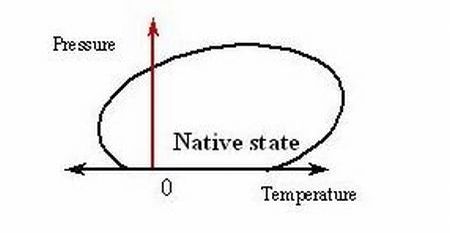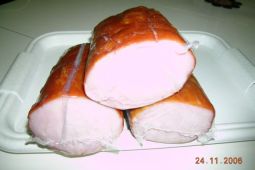Research
Recently, high pressure has increasingly found new applications in biological systems and has been proposed as a promising method for food preservation (HPP), alternative to conventional thermal processing. This technique is mainly use for pasteurisation of food products without the loss of original sensory qualities. It can be applied to a very large range of products.
The scientific basis for the process is discovery of the American physicist and Nobel Prize winner Bridgman who observed (1914) that the white of an egg is coagulated after a pressure treatment and that the treatment by pressure gives a different product than in the case of temperature treatment. In addition he found that at lower temperatures one needs a lower pressure to obtain the same effect. More detailed of investigations by Suzuki (1960) and Hawley (1971) have shown that these observation can be understood from the phase diagram for the denaturation of proteins. As shown in figure below , at high temperature, pressure stabilizes the protein against temperature denaturation. At room temperature, temperature stabilizes the protein against pressure denaturation.

Schematic diagram ilustrating the effect of temperature and pressure on the denaturation
of proteins based on experimental data
The treatment of food by ultrahigh pressure have been shown to drasticaly reduce the original microbiological population, leading to longer shelf-life. Although the discovery was made at the beginning of twentieth century the technique on food products has not been explored until 1990.
The first high-pressure-processed food products appeared in Japan in the early 1990s as a result of the interdisciplinary research program devoted to introducing high pressure in food processing. The development of high pressure processed products is growing in European and USA markets since the turn of the millenium.
In Poland, research on high pressure for food preservation was initiated in 1993 by the Institute of High Pressure Physics, Polish Academy of Sciences.
The first research program devoted to high-pressure-processing of fruit products and development of high-pressure food processors started by UNIPRESS in 1993 in close cooperation with the National Institute of Hygiene. This program was then continued and extended in cooperation with the Warsaw Agricultural University (SGGW) , Institute of Agricultural and Food Biotechnology and National Institute of Hygiene.
Main fields of our research are:
- studies of influence of HPP on micro-organisms including pathogenic bacteria and moulds
being reason of food-borne diseases
- investigations of HPP processing and food safety (pasteurisation and prolongation of the shelf-life
of different food products – fresh squeezed fruit and vegetable juices, fruit desserts and jellies,
meat and fishery products)
- HPP inactivation of enzymes
- studies of physicochemical changes and sensory quality of food products after HPP pasteurisation
- interpretation of cellular injuries after HPP treatment – electron microscopy (TES and SEM)
- general properties of soft matter systems under pressure, including extreme domains
(GPa, negative pressures).
Equipment
Special stand for testing commercially packed food samples exposed to high-pressure was created: high pressure food processor piston - cylinder type vessel with inner diameter of 110 mm, working volume of 1.5 L, and maximum pressure of 500 MPa, equipped with internal heat exchanger and thermocouple located in the middle of the vessel.
The pressure and temperature sensors are linked to the Computer Data Acquisition System (Memory Card MMC) . This equipment allows for analysis of the variation of temperature in relation to pressure. The pressure-transmitting medium used is the mixture of distilled water and propylene glycol (1:1). The vessel is thermostated using the HUBER Compatybile Control-Thermostat CC 245.
Example of High Pressure Processing of samples of food in 1.5 L chamber
The time for reaching the working pressure (200, 300 and 400 MPa) was generated in 15-20s, release time – 15 s. Variation of temperature in high pressure vessel during pressurisation of smoked salmon samples (about 30-50 g) is about 2 C.
Main results
Several research programmes were realised:
- effects of different high-pressure treatments on strains of microorganisms Gram(+) and Gram(-)
identified in literature as components of pathogenic and saprophytic microflora of food,
as well as on spores of Bacillus subtilis, selected moulds and yeasts
High pressure inactivation of microorganisms in carrot juice (temp 4 C, time 5 min)
A B C
High pressure inactivation of Escherichia Coli in apple juice
(A - Control - log cfu/ml = 7, B - 200 MPa, C - 300 MPa)
- calculations of the D-values and z-values for pathogenic Listeria monocytogenes, after inactivation
of this microorganism in minced meat, cured ham, ripening cheeses, fish and fruit and vegetable
juices, to predict the efficacy of high pressure processing. D-value indicates time necessary for
decimal reduction of L. monocytogenes number for given pressure level
D-value for Listeria monocytogenes in smoked fish vacuum-packed:
300 MPa - 4,78 min
400 MPa - 3,39 min
500 MPa - no bacteria
- changes of the volatiles composition of spices induced by ultra High Pressure and/or heat
treatment in inert gases and air
- studies of cellular injuries after HPP treatment (TES and SEM) of yeasts, Streptomyces sp,
Lactic acid bacteria and halophilic bacteria - Chromohalobacter beijerinckii
A B
Electron micrograph of Chromohalobacter beijerinckii:
A - before pressure treatment and B - after exposure 400 MPa
A B
Electron micrograph of Saccharomyces cerevisiae:
A - before pressure treatment and B - after exposure 400 MPa
Applied Research
- elimination of pathogenic bacteria and shelf-life prolongation by HPP of: commercial fresh
squeezed carrot juices, commercial vacuum-packed meat products and commercial
vacuum-packed smoked fishery products
- studies on physicochemical changes in high-pressure-processed fruit desserts sweetened
with aspartame, ham, loin

In the range of pressure levels treatment times and temperature applied in our experiments calculated D-value for different microorganisms might be useful to predict the extend of bacteria inactivation ( e.g. Listeria monocytogenes) in various food products.
It seems, that appriopriate selection of technological parameters will enable us to obtain good microbiological results and of the same time inconsiderable changes in organoleptic and functional properties of products.
Institute of High Pressure Physics of PAS, after ten years of applied and scientific research concerning high pressure food processing according to EU legislation, applied to Polish Health Authorities and at 2002 received a positive decision from the Chief Sanitary Inspector for production and marketing HPP food products in Poland. The list of products includes fruit products processed under pressure of 200-600 MPa and vacuum packed meat products processed under 350-600 MPa.
Present investigation
1. Research on possibility of elimination of bacteria spores from foods
2. Elimination of histamine producing bacteria, from smoked salmon, with HPP
3. High pressure studies linking microbiology and physics on bio-matter and selected food products.
In the nearest future the focus on mortality curves at extremes, i.e. at sub-zero temperatures
and negative pressures. The link of expected curve (see below) with the pressure-temperature
denaturation curve is under elaboration.
Fig. The Figure shows the mortality curve of E.coli. The black colour is for experimental data.
Does the curve continuous in T < 0 (oC) and P < 0 domains, similarly to the denaturation curve
in the P – T plane ? This hypothetical domain is shown as the red – dashed curve.
The domain T < 0 (oC) may be determined from the estimation under high pressure.
The negative pressures domain may be reached from the Berthelot tube based experiment.

